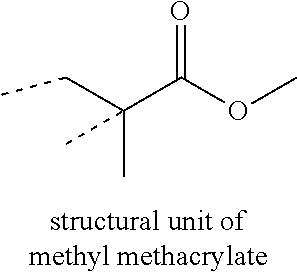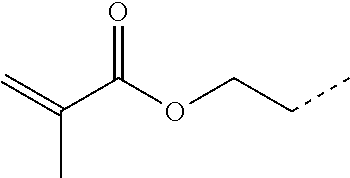Bimodal adsorbing latex
a technology of bimodal adsorption and latex, applied in the field of latex, can solve the problems of increasing costs and storage requirements, polymer particles tending to agglomerate, and increasing viscosity, and achieve the effect of high solids latex and high hiding efficiency
- Summary
- Abstract
- Description
- Claims
- Application Information
AI Technical Summary
Benefits of technology
Problems solved by technology
Method used
Image
Examples
example 1
Bimodal Aqueous Emulsion Copolymer with Acorn Morphology
A. Pre-form Intermediate
[0029]A first monomer emulsion was prepared by mixing (DI water) 200 g, Disponil FES 993 anionic surfactant (64 g, 30% active), butyl acrylate (371.2 g), methyl methacrylate (195.2 g), allyl methacrylate (9.6 g), phosphoethyl methacrylate (51.2 g, 60% active), and methacrylic acid (12.8 g).
[0030]To a 5-liter, four-necked round-bottom flask equipped with a paddle stirrer, a thermometer, N2 inlet, and a reflux condenser was added DI water (600 g) and Disponil FES 993 anionic surfactant (21.3 g, 30% active). The contents of the flask were heated to 85° C. under a N2 atmosphere, and stirring was initiated. A portion of the first monomer emulsion (70 g) was then added, quickly followed by addition of an aqueous solution of sodium persulfate (2.56 g in 30 g DI water) and a further rinse with deionized water (5 g). After stirring for 10 min, the remainder of the first monomer emulsion, followed by a DI rinse (2...
PUM
| Property | Measurement | Unit |
|---|---|---|
| Temperature | aaaaa | aaaaa |
| Temperature | aaaaa | aaaaa |
| Temperature | aaaaa | aaaaa |
Abstract
Description
Claims
Application Information
 Login to View More
Login to View More - R&D
- Intellectual Property
- Life Sciences
- Materials
- Tech Scout
- Unparalleled Data Quality
- Higher Quality Content
- 60% Fewer Hallucinations
Browse by: Latest US Patents, China's latest patents, Technical Efficacy Thesaurus, Application Domain, Technology Topic, Popular Technical Reports.
© 2025 PatSnap. All rights reserved.Legal|Privacy policy|Modern Slavery Act Transparency Statement|Sitemap|About US| Contact US: help@patsnap.com



